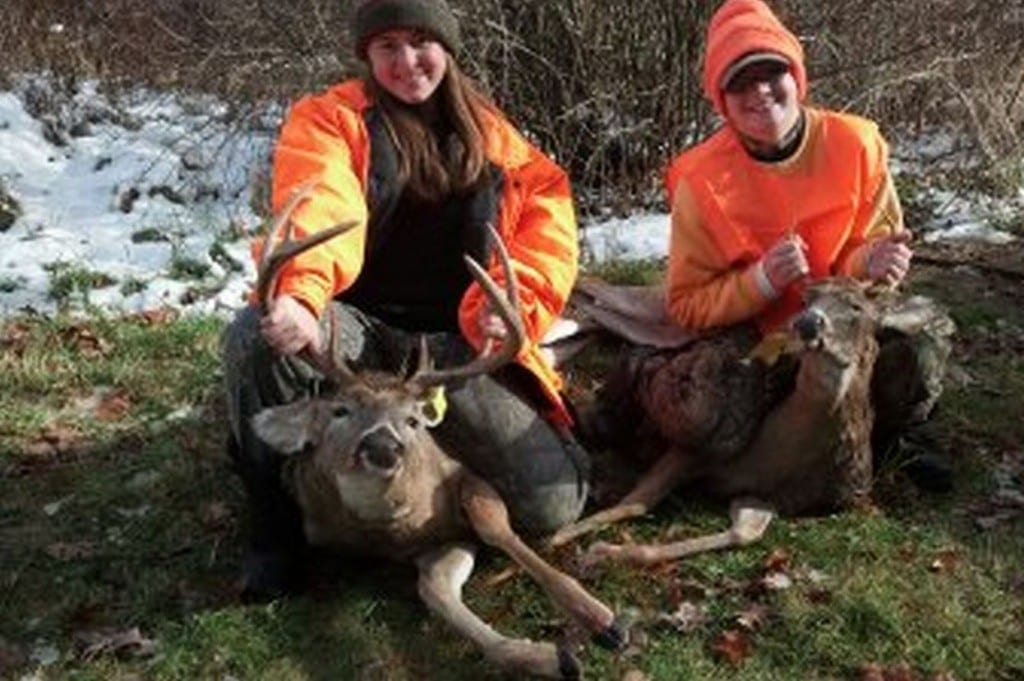Commentary: Women are fastest growing group of outdoors participants
Prefatory Note by Natalie Jarnstedt
 Hunters are decreasing in numbers, nationally and in more states than not, so they have been preying on young kids for youth hunts, and “independent”, “strong” women to take up the slack, They never use “kill”, but euphemisms like take, harvest, bag, remove, down…. (you name it!.) They see no problem with publishing sanitized cruelty, making the carcass look life-like, yet would never show reality of blood trickling from their mouths, blood at entry wound of gunshot or arrow (conveniently removed and hidden), with smiling or grinning killers proudly holding up the carcasses….
Hunters are decreasing in numbers, nationally and in more states than not, so they have been preying on young kids for youth hunts, and “independent”, “strong” women to take up the slack, They never use “kill”, but euphemisms like take, harvest, bag, remove, down…. (you name it!.) They see no problem with publishing sanitized cruelty, making the carcass look life-like, yet would never show reality of blood trickling from their mouths, blood at entry wound of gunshot or arrow (conveniently removed and hidden), with smiling or grinning killers proudly holding up the carcasses….
Field & Stream has an ad that local sports shops can use to sell their killing wares, making it really patriotic to kill animals, with camo-clad, armed women and men, military-style, defending us from those dangerous terrorist animals out there. Preying on patriotism, Homeland Security style, it is now heroic to kill defenseless animals.
The family that kills together, stays together, eh?
Non-consumptive outdoor activities actually bring more money to states than hunting, yet they very cleverly imply that hunting is the only outdoor activity…
See: Find the entire “Women in the Outdoors” survey at www.southwickassociates.com. SICK, SICK, SICK!
I corresponded with a newspaper editor in Oregon a few years ago, complaining about printing trophy photos of a hunter with a mountain lion, sanitized to look life-like, asking why bloody reality couldn’t be depicted – he said that people would be turned off by blood and gore… no shit, Sherlock! How do they think the animals died, by hypnotism?
http://m.youtube.com/watch?v=vdvMMKFC7vA&desktop_uri=%2Fwatch%3Fv%3DvdvMMKFC7vA
Women are fastest growing group of outdoors participants
October 26, 2013
For more than a decade, we’ve been hearing about declining outdoors participation — particularly in hunting, particularly among young people.
But beneath the headlines, data show the fastest-growing segment of outdoors users — including in hunting, including the young — is comprised of women.
More than a quarter of all freshwater anglers are women, and while the percentage of female hunters is lower, their numbers are growing.
“Many people may be surprised to learn the traditional view of the outdoors person is changing. But to anybody who hunts, fishes and shoots, the presence of women on the water, in the woods and at the range is anything but new, and certainly not surprising,” said Rob Southwick, president of Southwick Associates.
The Florida-based polling company he formed in 1989 is paid to gather data for studies commissioned by the U.S. Fish and Wildlife Service, state wildlife agencies and nonprofit environmental groups, and compile market data for sportfishing and other outdoors-related industries.
Noticing raw data in many unrelated polls showing a trend in rising outdoors participation among women, Southwick took the unusual step of culling and repackaging data on women from three years of studies. The data were compiled in a new survey, “Women in the Outdoors 2012,” and released to the media.
“Typically when you look at data reflecting cultural change, you’re not seeing monumental shifts,” Southwick said. “Changes can be real slow — a percentage point or two. But over the U.S. population at large, that can include a huge number of people. That’s what we’re seeing among women participating in outdoor recreation.”
U.S. Fish and Wildlife data, collected in part by Southwick, shows that in 2001, 26.1 percent of freshwater anglers and 9.2 percent of hunters were female. In 2011, women comprised nearly 27 percent of all inland anglers and 11 percent of hunters.
Southwick’s data shows that while women are participating more in traditional outdoors recreation, their preferences are sometimes different than those of men.
Overwhelmingly, guys like to target specific fish species. Sixty-three percent go after largemouth and spotted bass, and to a lesser degree they fish for panfish, trout, smallmouth bass and catfish. While 27 percent of men are happy to catch non-targeted species, 43 percent of women prefer to fish for “whatever bites.”
According to the Southwick study, 86 percent of women fish to spend time on or near the water, and more so than men, they view fishing as an opportunity to spend time with family and friends (84 percent to 71 percent).
Women use dead bait including fish eggs, cut fish and commercially processed baits more than men (38 percent to 28 percent), and a higher percentage of women than men prefer to fly fish (23 percent to 20 percent).
Locally, many women fit Southwick’s profiles.
Jennifer Shook of West Deer is a prolific angler. She fishes about every other day in the summer, plans to go ice fishing if the weather cooperates and wants to explore hunting.
“The thing that I most enjoy about fishing is that I always catch interesting fish,” she said. “I love the fight that they give while you’re trying to reel them in.”
Kate Toth of White Oak learned to fish from her father and continued on her own as she grew older. She took her kids fishing and is now passing the tradition to her grandson.
“It can be a challenge because you have to know what you’re doing — what you do to catch a trout is different than trying to catch a bass,” she said. “It can be relaxing because you’re sitting in the peaceful outdoors, happy, communing with nature.”
Toth is among the women registered for an upcoming Post-Gazette steelhead-fishing bus trip to Lake Erie tributaries.
Nationally about a half million women hunt, and a million hunt and fish. The hunting target of choice among men and women is deer (slightly more than 70 percent). Target preferences remain about the same for both sexes, but significantly fewer women hunt for coyote, upland game and dove. More women than men hunt for elk (10 percent to 6 percent).
At 17, Samantha Morgan of the North Side has downed more deer than many guys. Raised in a hunting family, she had her first crossbow kill at 14 and has taken a spike, 7-point, 8-point, 6-point and a doe. Last year, on the opening day of rifle deer season, she and her sister Mekenzie Saban each harvested a buck — Mekenzie, then 14, took a 130-inch 9-point.
“Our family is tight-knit. We fish all the time and camp” said Samantha. “I just have a really good balance of things. I follow trends — I’m a teenage girl and like the girly stuff — but I still like going out to deer camp and hanging with my dad and all the guys.”
Southwick said the trend among sportswomen has piqued the interest of outdoor products industries.
“The data is showing women don’t want to compete with men or do something that’s very specialized or demanding,” he said. “They’re realizing it’s just fun to get outside.”
Find the entire “Women in the Outdoors” survey at www.southwickassociates.com.









